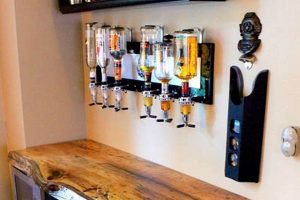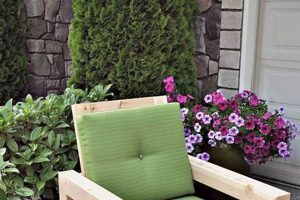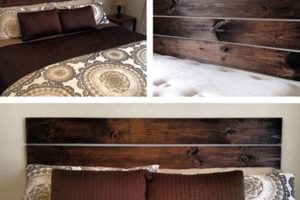Personalized smartphone protection, achieved through individual creation or modification of existing cases, offers a unique method for self-expression and device safeguarding. Examples include hand-painted designs, collages incorporating photographs or decorative elements, and the application of various crafting materials such as glitter, fabric, or resin.
The practice provides a cost-effective alternative to commercially available options while fostering creativity and resourcefulness. Its significance lies in the capacity to tailor a ubiquitous accessory to individual tastes and preferences, transforming a functional item into a personalized statement. Historically, the impulse to customize personal possessions has been a consistent human behavior, finding contemporary expression in this domain.
The subsequent sections will explore a range of techniques and materials suitable for constructing personalized smartphone cases, including detailed instructions and considerations for design and durability. Factors impacting longevity and aesthetic appeal will also be addressed.
DIY Phone Cover Creation
The following provides guidelines to enhance the effectiveness and longevity of self-made smartphone protection. Adherence to these principles can mitigate potential damage and ensure the final product reflects intended aesthetics.
Tip 1: Material Selection: Employ durable materials suitable for impact absorption. Rigid plastics, reinforced polymers, and flexible silicones provide varying degrees of protection. Consider material properties in relation to anticipated environmental stressors.
Tip 2: Adhesion Integrity: Utilize adhesives designed for the specific materials being joined. Inadequate bonding agents can result in premature detachment of decorative elements or structural failure of the casing. Test adhesive compatibility on scrap materials prior to final assembly.
Tip 3: Surface Preparation: Clean and prepare the surface of the existing case or base material prior to application of adhesives or coatings. Contaminants such as grease, oils, or particulate matter can compromise adhesion and aesthetic quality. Abrading smooth surfaces can enhance mechanical bonding.
Tip 4: Design Planning: Outline a clear design schematic prior to commencing construction. Consider ergonomic factors such as button accessibility and port clearance. Scale designs appropriately to the dimensions of the device.
Tip 5: Sealing and Finishing: Apply a sealant or protective coating to the completed case to protect against environmental factors and physical abrasion. UV-resistant coatings can prevent color fading and material degradation. Ensure complete coverage, particularly around edges and seams.
Tip 6: Structural Reinforcement: Integrate reinforcing elements into the design where necessary. Thin or fragile areas of the case can be strengthened with embedded mesh, additional layers of material, or structural supports. Evaluate stress points and address potential weak areas.
Tip 7: Precision Cutting: Employ precision cutting tools and techniques to ensure accurate dimensions and clean edges. Inaccurate cuts can result in poor fitment, compromised functionality, or aesthetic imperfections. Consider the use of templates or guides to improve accuracy.
Adherence to these guidelines will contribute to a more robust, aesthetically pleasing, and functional customized smartphone case. Prioritization of material selection, adhesion, design, and finishing is crucial for achieving optimal results.
The subsequent section will address specific techniques, including painting, decoupage, and molding, providing detailed instructions for each method.
1. Aesthetics
Aesthetic considerations are integral to the personalized smartphone case. The visual appeal of a phone cover, as a readily visible extension of the user’s personal style, contributes significantly to the perceived value of the modification. Color palettes, patterns, and decorative elements all influence the overall aesthetic impact. For instance, a minimalist design utilizing muted colors conveys a sense of sophistication, whereas a vibrant, patterned design reflects a more expressive personality. The choice of these elements dictates whether the case complements or detracts from the device itself.
The implementation of aesthetic principles extends beyond mere surface decoration. The arrangement of design elements, the balance between positive and negative space, and the integration of texture all contribute to a cohesive visual experience. A poorly executed design, regardless of the materials used, can undermine the intended aesthetic. Consider the practical application of image transfer techniques. High-resolution images, carefully selected and properly applied, can create a visually compelling and personalized case. Conversely, poorly scaled or distorted images detract from the overall aesthetic.
In conclusion, the aesthetic dimension of customized phone covers transcends superficial ornamentation. It encompasses thoughtful design choices, careful execution, and a consideration of how the finished product reflects the user’s individual aesthetic preferences. Overlooking these principles can result in a visually unappealing outcome, negating the benefits of personalization and potentially detracting from the perceived value of the smartphone itself. Attention to aesthetic detail enhances the overall user experience and contributes to the successful implementation of this customization endeavor.
2. Durability
The long-term utility of any self-constructed smartphone case is intrinsically linked to its resistance to physical degradation. A case that fails to withstand the rigors of daily use negates the benefits of personalization and protective function. Therefore, durability is a paramount consideration in the design and execution of these projects.
- Material Composition
The inherent properties of the chosen material directly influence the lifespan of the case. For instance, thermoplastic polyurethane (TPU) offers a balance of flexibility and impact resistance, while hard plastics, such as polycarbonate, provide rigidity but may be more susceptible to cracking under stress. The selection must align with anticipated usage conditions and potential environmental stressors.
- Construction Techniques
Methods employed in assembling the case significantly impact its structural integrity. Weak joints or inadequate adhesive bonds can lead to premature failure. Reinforcement strategies, such as incorporating internal supports or applying multiple layers of material, can enhance overall resilience. The precision of cuts and alignments also contributes to the case’s ability to withstand deformation and impact.
- Protective Coating Application
The application of protective coatings, such
as varnishes or sealants, serves to shield the underlying materials from abrasion, UV radiation, and moisture. These coatings, if properly selected and applied, extend the case’s lifespan by mitigating environmental damage. However, the coating’s own durability must be considered, as a brittle or easily scratched finish can compromise the overall protective function. - Design for Stress Distribution
The design should account for potential stress points and distribute forces effectively. Sharp corners or thin sections are prone to cracking under impact. Rounding edges and reinforcing vulnerable areas can mitigate these risks. The design must consider not only the aesthetic appeal but also the structural integrity of the final product.
The interplay of material selection, construction methods, protective coatings, and design considerations determines the overall durability of a smartphone case. A focus on these elements will lead to the creation of a long-lasting and functional accessory, realizing the full potential of personalized smartphone protection.
3. Materials
The selection of appropriate materials constitutes a fundamental determinant in the success of any self-directed smartphone case modification. Material properties directly impact both the aesthetic characteristics and protective capabilities of the finished product. The subsequent discussion will explore key aspects of material consideration in this context.
- Polymeric Substrates
Thermoplastics, such as TPU and polycarbonate, are frequently employed as base materials due to their moldability and impact resistance. TPU offers flexibility and shock absorption, while polycarbonate provides greater rigidity and scratch resistance. The choice depends on the desired balance between protection and ease of customization. For example, hydrographic dipping techniques require substrates capable of withstanding immersion in water, while heat transfer methods necessitate materials with appropriate thermal conductivity.
- Adhesives and Bonding Agents
The integrity of any applied embellishments relies on the efficacy of the adhesive used. Cyanoacrylate adhesives (super glue) offer rapid bonding but may lack flexibility, while epoxy resins provide greater strength and chemical resistance but require longer curing times. Double-sided adhesive tapes provide a convenient alternative for attaching lightweight decorations. The compatibility of the adhesive with both the substrate and the decorative element is paramount to ensure long-term adhesion. For instance, affixing metal accents to a TPU case requires an adhesive formulated for bonding dissimilar materials.
- Decorative Elements
A diverse range of decorative elements, including paints, glitters, fabrics, and metallic accents, can be incorporated to personalize the case. Acrylic paints provide vibrant colors and can be sealed with a protective coating. Glitter adds sparkle and texture, while fabrics offer a tactile dimension. Metallic accents enhance the perceived value and can be affixed using appropriate adhesives. The selection of decorative elements should align with the overall design aesthetic and consider durability and resistance to wear and tear. For example, embedding rhinestones requires careful consideration of their size, shape, and method of attachment to prevent detachment during normal use.
- Protective Coatings
The application of a protective coating serves to enhance the durability and longevity of the customized case. Polyurethane varnishes provide a durable, scratch-resistant finish, while epoxy resins offer superior chemical resistance. UV-resistant coatings prevent fading and discoloration of the underlying materials. The choice of coating depends on the anticipated environmental exposure and the desired level of protection. For instance, a case frequently exposed to sunlight benefits from a UV-resistant coating to prevent fading of colors and degradation of the materials.
In summary, the judicious selection of materials is crucial for achieving a successful outcome in customized smartphone case creation. Careful consideration of the properties of the substrate, adhesives, decorative elements, and protective coatings is essential to ensure both aesthetic appeal and long-term durability. The interplay of these factors determines the overall quality and functionality of the final product, underscoring the importance of informed material selection in this endeavor.
4. Protection
The capacity to mitigate potential damage to the enclosed electronic device constitutes a primary function of any smartphone case. Customized or self-made iterations are not exempt from this fundamental requirement; therefore, the level of protection offered is a critical design consideration.
- Impact Resistance
Impact resistance refers to the ability of the case to absorb and dissipate energy from impacts, thereby preventing damage to the phone’s internal components or screen. Material selection and case design play a significant role. For example, cases constructed from thermoplastic polyurethane (TPU) generally offer superior impact absorption compared to those made from rigid plastics. A raised bezel around the screen and camera lens provides additional protection against direct contact with surfaces.
- Scratch Prevention
Scratch prevention involves safeguarding the phone’s surface from abrasive damage. This is particularly important for the screen and camera lens, which are vulnerable to scratches from keys, coins, or other objects. A case with a smooth, non-abrasive inner lining can help prevent scratches on the phone’s back. The outer surface of the case should also be scratch-resistant. For instance, applying a clear coat of durable varnish can protect decorative elements from scratches and wear.
- Environmental Shielding
Environmental shielding refers to the case’s ability to protect the phone from environmental factors such as dust, moisture, and extreme temperatures. A well-designed case should minimize the ingress of dust and moisture, which can damage internal components. Sealed buttons and port covers provide additional protection. Cases constructed from materials with low thermal conductivity can help insulate the phone from extreme temperatures. As an example, cases designed for outdoor use often incorporate features such as water-resistant seals and reinforced corners.
- Structural Integrity
Structural integrity refers to the case’s ability to maintain its shape and form under stress. A structurally sound case will not deform or crack easily, even under significant pressure. Reinforced corners and edges enhance structural integrity. The method of construction also plays a role. For instance, a case that is molded in a single piece will generally be more structurally sound than one that is assembled from multiple pieces. The structural integrity of the case contributes directly to its ability to protect the phone from physical damage.
The protective capabilities of DIY smartphone cases are directly influenced by the selection of appropriate materials, the implementation of sound construction techniques, and attention to design details. While aesthetic considerations are important, the primary function of any phone case remains the safeguarding of
the enclosed device from potential damage. Prioritizing protective features will ensure that the customized case provides not only personalized style but also reliable protection.
5. Ergonomics
Ergonomics, the science of designing and arranging items for efficient and safe use, constitutes a crucial, albeit frequently overlooked, element in the creation of customized smartphone cases. The dimensions, shape, and surface texture of a case profoundly influence the user’s ability to interact comfortably and effectively with the device. Poorly designed cases can induce discomfort, fatigue, and even repetitive strain injuries. Therefore, a thorough understanding of ergonomic principles is essential to ensuring that a self-made phone cover enhances, rather than detracts from, the user experience. For instance, a case that adds excessive bulk to the device can make it difficult to hold and operate with one hand, while sharp edges or rough surfaces can irritate the skin.
The practical application of ergonomics in DIY phone cover design manifests in several key areas. Careful consideration of hand size and grip strength informs the case’s overall dimensions and shape. Contoured designs that conform to the natural curvature of the hand promote a more secure and comfortable grip. Textured surfaces, such as raised patterns or rubberized coatings, enhance grip and reduce the likelihood of accidental drops. Strategically placed finger grooves can provide additional support and stability. Furthermore, ensuring unobstructed access to buttons and ports is paramount. Recessed or enlarged button covers can facilitate easier operation, while precisely cut openings for charging and headphone ports prevent interference with cable connections. Consider the example of a case designed with a deeply recessed power button, rendering it difficult to activate the device without significant effort. Such a design flaw highlights the importance of ergonomic testing and refinement throughout the creation process.
In summary, ergonomics constitutes an indispensable component of successful DIY phone cover creation. Ignoring ergonomic principles can lead to discomfort, reduced functionality, and potential health risks. By prioritizing user comfort, grip security, and accessibility, creators can ensure that their customized phone covers not only reflect personal style but also enhance the overall user experience. While challenges exist in balancing aesthetic desires with ergonomic considerations, the pursuit of a design that harmonizes form and function remains the ultimate goal. Understanding and applying ergonomic principles is critical to create smartphone cases that promote both comfort and usability.
6. Affordability
Cost-effectiveness is a primary motivator for pursuing self-directed smartphone case creation. Commercially available cases vary widely in price, and customized options frequently command a premium. The DIY approach offers a potential avenue for achieving personalized device protection while minimizing expenditure.
- Material Sourcing Strategies
Acquiring materials from cost-effective sources is crucial. Utilizing repurposed materials, such as discarded fabrics or recycled plastics, can significantly reduce expenses. Bulk purchasing of common materials, such as paints or adhesives, can also yield savings. Comparison shopping across various retailers, including online marketplaces and local craft stores, enables identification of the most economical options. For instance, sourcing glitter from a discount store rather than a specialty craft supplier can result in substantial cost reductions.
- Tool Investment Considerations
While certain specialized tools may enhance the quality and efficiency of the DIY process, minimizing unnecessary investment is essential for maintaining affordability. Utilizing readily available household tools, such as scissors, knives, and rulers, can reduce the initial cost outlay. Borrowing or renting specialized tools, such as heat guns or cutting machines, can also be a cost-effective alternative to purchasing them outright. Prioritizing essential tools and gradually acquiring more specialized equipment as needed allows for a phased approach to tool investment.
- Minimizing Waste and Errors
Efficient use of materials and careful planning of the design can minimize waste and reduce the need for costly rework. Creating detailed templates or patterns prior to cutting or assembling materials can prevent errors. Practicing techniques on scrap materials before committing to the final design reduces the risk of irreversible mistakes. Careful storage and handling of materials prevent spoilage and extend their usable lifespan. For example, properly sealing paints and adhesives after each use prevents them from drying out and becoming unusable.
- Lifecycle Cost Analysis
While the initial cost of a DIY phone case may be lower than that of a commercially available option, considering the long-term cost implications is essential. Selecting durable materials and employing robust construction techniques can extend the case’s lifespan, reducing the need for frequent replacements. The cost of repairs and maintenance should also be factored into the analysis. A DIY case constructed from inexpensive but fragile materials may require more frequent replacement than a commercially available case constructed from more durable materials, potentially negating any initial cost savings.
The pursuit of affordable smartphone protection through DIY methods requires careful consideration of material sourcing, tool investment, waste minimization, and lifecycle cost analysis. A strategic approach to these factors enables the creation of personalized cases without exceeding budgetary constraints. The balance between initial cost savings and long-term durability should be carefully evaluated to ensure the overall cost-effectiveness of the DIY endeavor.
7. Personalization
The nexus between individualized smartphone protection and self-directed design methodologies centers on the concept of personalization. This element transcends mere aesthetics, serving as a tangible expression of individual identity and preferences. The opportunity to create a phone case that directly reflects personal interests, affiliations, or artistic sensibilities constitutes a primary driver for engaging in DIY endeavors. For example, a photography enthusiast may incorporate original images into a case design, while a music aficionado might feature album art or band logos. These choices transform a utilitarian object into a curated representation of self.
The importance of personalization in this context extends beyond self-expression. It allows for the adaptation of device protection to specific functional requirements. A user with limited dexterity might design a case with enhanced grip features, while an outdoor enthusiast might incorporate elements such as a lanyard attachment point or a water-resistant seal. The cause-and-effect relationship is evident: the desire for tailored functionality and aesthetic expression directly leads to the adoption of DIY methods. Furthermore, this understanding has practical significance for individuals seeking un
ique solutions that are not readily available through commercial channels. Examples include cases designed with integrated stands for video conferencing or modular components that allow for interchangeable designs.
In conclusion, personalization forms the bedrock of the connection between DIY phone cover design and user engagement. It empowers individuals to transform a mass-produced item into a personalized artifact that aligns with their specific needs and aesthetic values. The challenges associated with this approach, such as ensuring durability and achieving professional-grade finishes, are often outweighed by the satisfaction of creating a truly unique and functional accessory. This understanding is crucial for both individuals seeking customized solutions and manufacturers seeking to incorporate elements of personalization into their product offerings.
Frequently Asked Questions
The following elucidates common inquiries pertaining to the creation and implementation of personalized smartphone casings. The information provided seeks to address practical considerations and dispel potential misconceptions.
Question 1: What types of materials are most suitable for creating durable smartphone covers?
Thermoplastic polyurethane (TPU) and polycarbonate are frequently employed due to their impact resistance and flexibility. Silicone offers excellent shock absorption, while leather provides a premium aesthetic but requires specialized tools for working.
Question 2: How can adhesion between decorative elements and the case substrate be maximized?
Proper surface preparation, including cleaning and abrasion, is crucial. Utilizing adhesives specifically formulated for bonding dissimilar materials is also recommended. Testing adhesive compatibility on scrap material prior to application is advisable.
Question 3: What techniques can be employed to ensure precise cutouts for buttons and ports?
The use of templates, precision cutting tools (such as craft knives or laser cutters), and careful measurement is essential. Creating mockups from cardboard or paper can aid in verifying fit and alignment prior to cutting the final material.
Question 4: How can the finished case be protected from scratches and UV damage?
Applying a clear coat of polyurethane varnish or epoxy resin can provide a durable, scratch-resistant finish. UV-resistant coatings prevent fading and discoloration caused by prolonged exposure to sunlight.
Question 5: What safety precautions should be observed when working with adhesives and cutting tools?
Adequate ventilation is necessary when working with adhesives and solvents. Wearing appropriate protective gear, such as gloves and eye protection, is recommended. Using sharp cutting tools with caution and employing cutting mats or safety rulers is crucial.
Question 6: How can the overall cost of DIY smartphone case creation be minimized?
Utilizing repurposed materials, purchasing supplies in bulk, and avoiding unnecessary tool investments can reduce expenses. Planning the design carefully and minimizing waste are also important cost-saving measures.
The successful creation of individualized smartphone cases hinges upon informed material selection, meticulous execution, and adherence to safety protocols. Addressing these common concerns can mitigate potential challenges and enhance the final product.
The subsequent section will address common pitfalls and troubleshooting techniques encountered during the DIY process.
Conclusion
This exploration of personalized smartphone protection, often referred to as “diy phone cover ideas,” has illuminated key considerations for successful implementation. Material selection, adhesion techniques, design principles, and ergonomic factors contribute to the overall durability, functionality, and aesthetic appeal of the resulting product. Adherence to safety protocols and a strategic approach to affordability are also essential for maximizing the value of this endeavor.
Ultimately, the pursuit of customized smartphone cases represents a convergence of individual creativity and practical device protection. Continued refinement of techniques and exploration of innovative materials will undoubtedly shape the future of this evolving domain. Consider this information as a foundational resource for creating a functional and personalized accessory.







